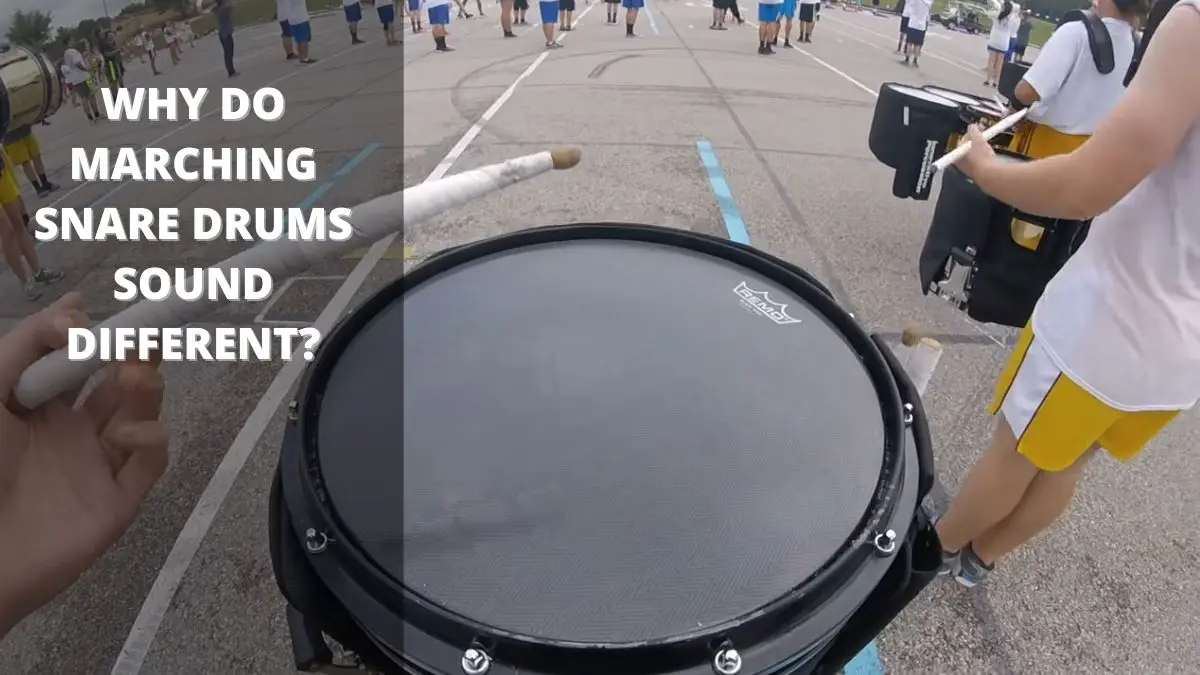Marching drums are usually played with a bass drum, snare drum, and cymbals. The different sounds the drums make when marching can be attributed to how they are hit.
A marching drummer will use their shoulder and arm muscles to hit the drum harder, which gives it a different sound. The bass drum is hit with the heel of the hand, while the snare drum is hit with the fist. The cymbals are hit with both hands at the same time.
Marching snare drums are usually tuned to a particular pitch, which can make them sound different from one another. The tuning process involves adjusting the tension on the drumhead, which affects the frequency at which the drum vibrations are transmitted. This can result in different pitches for different drums.
Marching snare drum sounds different than a regular snare drum
The snare drum is one of the most recognizable instruments in all of music. Its simple but powerful sound has been heard by audiences around the world for centuries.
However, the sound of a marching snare drum is quite different than that of a regular snare drum. Marching snare drums are typically much larger and have more metal in them than regular snare drums. This extra metal gives the marching snare drum its characteristic booming sound.
The snare drum is the most important instrument in a marching band. The marching snare drum, more than any other part of the marching band, is responsible for giving the band its sound.
Why are marching snare drums so loud?
Marching snare drums can be incredibly loud, even when played quietly.
There are many factors that contribute to the loud sound of marching snare drums, including their size and construction. These include:
- Because they are cylindrical, marching snare drums can be very loud.
- Marching snare drums are notoriously loud because of their size and the way they are played. They are often made of metal and have large heads. The large head creates a lot of air pressure when the drum is struck, which amplifies the sound. This sound is also amplified by the marching band members, who are often stomping their feet and waving their arms in unison.
- The drum is struck with a stick against the head, causing it to vibrate rapidly. This vibration is then amplified by the drum’s metal shell and membranophone skin, making the drum sound very loud.
- Another reason is for their high-pitched sound is that they are typically tuned to a very high pitch. This allows them to be heard over a large area, and also makes them stand out.
- Marching snare drums are traditionally very loud because they are used to create a rhythmic beat that is the foundation of many parade and performance marches. They are also used in marching bands, drum corps, and other types of marching performances.
How many snares are in a marching band?
Snare drums are the most common instrument in a marching band, making up around 60% of the ensemble. Marching bands are famous for their intricate and colorful uniforms and often include a number of snares.
They often have a large number of snares, which are instruments that produce a clicking sound. Many marching band musicians use snares to create rhythms and melodies.
Marching bands typically have between 18 to 24 snares, which are placed around the drumline. These snares can be used for various purposes, such as providing a backbeat for the band, creating a rhythmic melody, or adding an accent to certain notes.
How loud are marching snare drums?
Marching snare drums are one of the most popular percussion instruments in use today. They are often used in marching bands and other traditional percussion ensembles. They can be quite loud, depending on the size and make of the drum. Larger drums can produce higher-pitched sounds, while smaller drums can produce lower-pitched sounds. Some marching snare drums can even reach levels as high as 105dBa.
Further, they can be played at volumes that are extremely loud. However, because the drums are tightly packed together, reverberation and feedback can create a powerful sound that is difficult to control.
How do you practice snare drums quietly?
Practicing your snare drums quietly is essential to achieving an optimal sound. Practicing your snare drum quietly can help you to develop better techniques and improve your overall sound.
There are many different ways to practice your snare drum quietly, so find one that works best for you. There are a few techniques you can use to achieve this goal.
- Use headphones when practicing. This will help to reduce the noise of your drums and allow you to focus on your playing.
- Place your drums in a quiet location.
- Muffled drum heads can reduce the noise of a drum kit.
- Practice in an empty room or space with minimal distractions. You can focus on your drums and learn to play without being distracted by other sounds.
- You can also try to minimize the distance from your drums to the walls, ceiling, and floors.
- You should also practice in any other room you have available. You will find that you can use any of these techniques to achieve a quiet and focused sound while playing your drums.
- You can purchase an acoustic snare drum kit that is designed to be played quietly.
Conclusion
Marching snare drums sound different due to the type of marching they are used in, the type of music being played, and how they are tuned.
Each marching band has its own sound, and it is up to the drummer to create that sound. There are many techniques that can be used to make a marching snare drum sound different, and it is up to the drummer to find what works best for them.
Reference
- Noise Exposure Associated with Marching and Pep Bands


